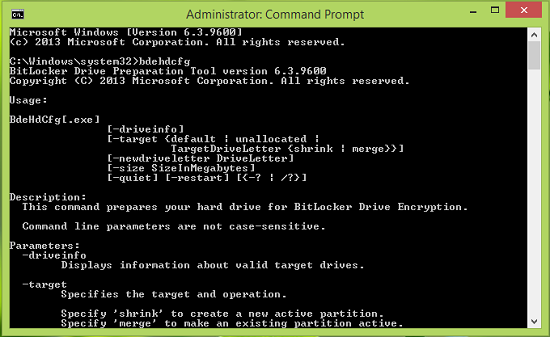We have previously read about the BitLocker feature, where we’ve mentioned the BitLocker Drive Preparation Tool. This tool is currently not available as a download for Windows 111/0/8/7/Server. But if you still want to use the abilities of this tool, then you can use the command-line tool. In this article, we will talk about using the BitLocker Drive Preparation Tool using Command Prompt in Windows 10.

Basically, BitLocker Drive Preparation tool prepares a hard drive with the partitions necessary for BitLocker Drive Encryption. Most installations of Windows 7 or later recognize the command-line tool. Here is how you can use it.
Using BitLocker Drive Preparation Tool via Command Prompt in Windows
1. In order to use BitLocker Drive Preparation command-line tool, open the administrative Command Prompt.
2. Next, you can use the following command with suitable descriptors mentioned below and press Enter:
bdehdcfg [–driveinfo <DriveLetter>] [-target {default|unallocated|<DriveLetter> shrink|<DriveLetter> merge}] [–newdriveletter] [–size <SizeinMB>] [-quiet]
The above-mentioned command is in general form and its variable parameters can be altered using the following descriptors:
This displays the drive letter, the total size, the maximum free space, and the partition characteristics. Only valid partitions are listed. Unallocated space is not listed if four primary or extended partitions already exist-
-driveinfo <DriveLetter>:
Example: To display information for C: drive, use bdehdcfg –driveinfo C: command.
Prepares a partition for use as a system drive by BitLocker and Windows Recovery. By default, this partition is created without a drive letter-
-target {default|unallocated|<DriveLetter> shrink|<DriveLetter> merge}
Example: In order to use this command to designate an existing drive (K) as the system drive, use bdehdcfg -target K: merge at Command Prompt.
Assigns a new drive letter to the portion of a drive used as the system drive. As a best practice, it is recommended that you do not assign a drive letter to your system drive-
-newdriveletter
Example: Using command bdehdcfg -target default -newdriveletter K: illustrates that default drive is being assigned the drive letter K.
Specifies the size of the system partition when a new system drive is being created. The default is 300 MB in minimum size is 100 MB-
-size <SizeinMB>
Example: Use command bdehdcfg -target default -size 500 to allocate 500 MB to the default system drive.
Informs the BitLocker Drive Preparation Tool that all actions and errors are not to be displayed in the command-line interface-
-quite
Example : bdehdcfg -target default -quiet
Use this to restart BitLocker Drive Preparation Tool after an operation is completed-
-restart
Example: BdeHdCfg.exe -target d: merge -quiet -restart
In this way, you can use the BitLocker Drive Preparation command-line tool.
Interested readers may visit TechNet and KB933246 to find out further possibilities.
See this post if you receive BitLocker Drive Encryption cannot be used because critical BitLocker system files are missing or corrupted (0x8031004A) error.
Related reads:
- BitLocker To Go in Windows
- Recover files & data from inaccessible BitLocker encrypted drive
- Encrypt USB Flash Drives with BitLocker To Go
- BitLocker Setup could not find a target system drive to prepare
- BitLocker Setup failed to export the BCD (Boot Configuration Data) store
- Your Recovery Key Couldn’t Be Saved To This Location error for BitLocker.